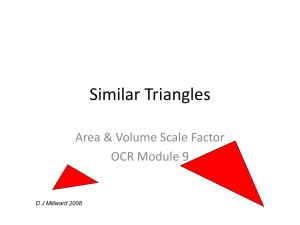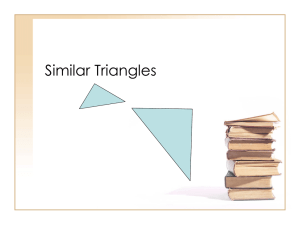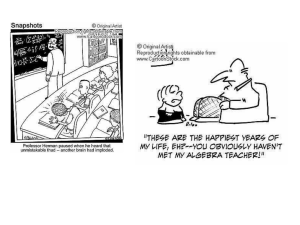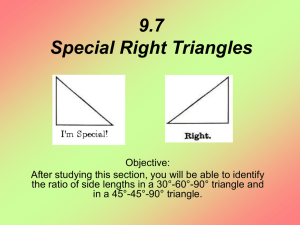MATH 131 Problem Set 1
advertisement
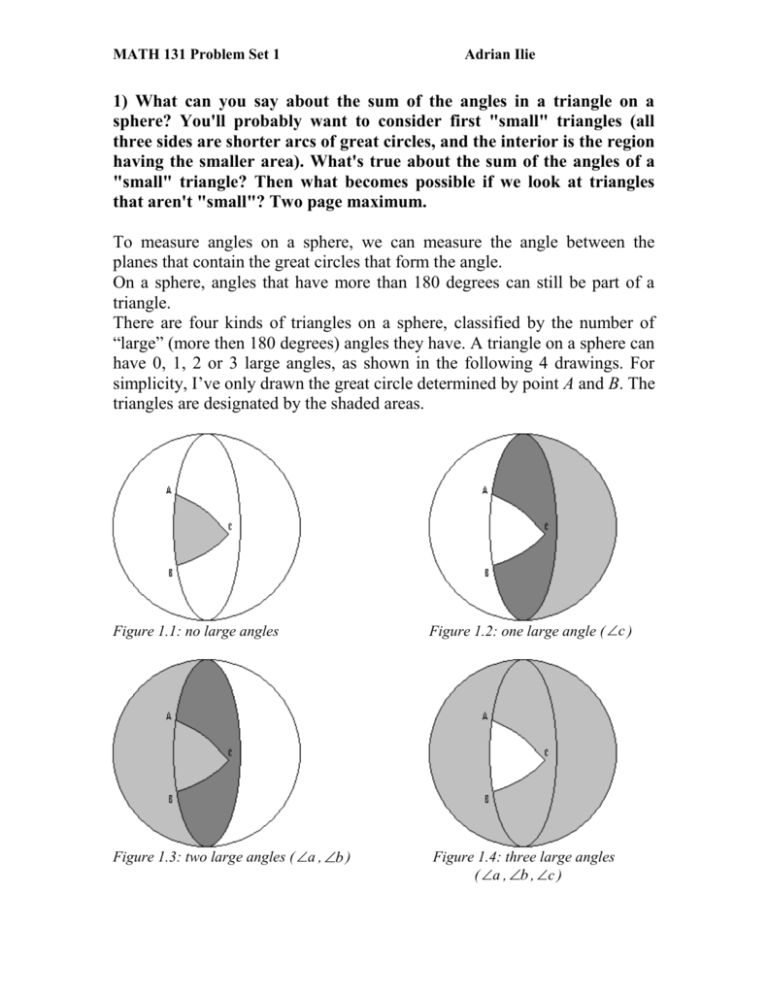
MATH 131 Problem Set 1 Adrian Ilie 1) What can you say about the sum of the angles in a triangle on a sphere? You'll probably want to consider first "small" triangles (all three sides are shorter arcs of great circles, and the interior is the region having the smaller area). What's true about the sum of the angles of a "small" triangle? Then what becomes possible if we look at triangles that aren't "small"? Two page maximum. To measure angles on a sphere, we can measure the angle between the planes that contain the great circles that form the angle. On a sphere, angles that have more than 180 degrees can still be part of a triangle. There are four kinds of triangles on a sphere, classified by the number of “large” (more then 180 degrees) angles they have. A triangle on a sphere can have 0, 1, 2 or 3 large angles, as shown in the following 4 drawings. For simplicity, I’ve only drawn the great circle determined by point A and B. The triangles are designated by the shaded areas. Figure 1.1: no large angles Figure 1.2: one large angle ( c ) Figure 1.3: two large angles ( a , b ) Figure 1.4: three large angles ( a , b , c ) MATH 131 Problem Set 1 Adrian Ilie A triangle with no large angles is a “small” triangle, and it’s the closest to what we call a triangle in a plane. However, because it’s on a sphere, the bigger it is, the larger is the sum of its angles. So, the minimum sum of the angles is 180 degrees, as it is on a plane. The maximum sum for small triangles is 3*180 degrees, because as the sides get further and further apart, the three great circles that form them get closer together, and the angle between them approaches 180 degrees. If we denote the angles of a small triangle with a , b , c , we can compute the sum of the angles for all types of triangles formed by point A, B and C. The formula for the sum of the angles in a small triangle is: S 0 a b c For a triangle with one large angle, the formula is: S1 (180 a) (180 b) (360 c) 720 a b c For a triangle with two large angles, the formula is: S 2 (180 a) (180 b) c 360 a b c For a triangle with three large angles, the formula is: S 3 (360 a) (360 b) (360 c) 1080 a b c Since we bounded S0 between 180 and 540 degrees, it follows that the values of the sums are bounded as shown in the next table. Sum S0 S1 S2 S3 In terms of S0 S0 720 - S0 360 + S0 1080 - S0 Minimum value 180 180 540 540 Maximum value 540 540 900 900 Table 1.1: minimum and maximum values for the sum of the angles of a triangle on a sphere MATH 131 Problem Set 1 Adrian Ilie We learned there are no squares on a sphere, since there are no parallel lines. The closest analog of a square (a pseudosquare?) would be a figure having four equal sides and four equal angles (technically, an equiangular rhombus). For simplicity, we assume the sides of a pseudosquare are shorter arcs of great circles, so the figure is a "small" polygon. Describe how a pseudosquare must be situated on the sphere and describe its symmetries. In particular: if you join the midpoints of opposite sides -- let's call this a midline of the pseudosquare -- show that this midline is perpendicular to both of the opposite sides. Must the two midlines be perpendicular to each other? And are the midlines longer, shorter, or the same length as the sides? Finally, what about the angles of the pseudosquare: can they be right angles? obtuse angles? acute angles? A pseudosquare is one of the two smaller figures enclosed by four great circles (there is another identical pseudosquare on the opposite side). It represents the intersection of two “slices” on the sphere’s surface, each slice formed by two great circles (light gray in Figure 2.1). Figure 2.1: a pseudosquare on a sphere As a square on a plane, the pseudosquare is symmetric with respect to its diagonals (AC, BD) and midlines (EG, FH) and has central (point) symmetry with respect to any other line (IJ) passing through its center (O) and the center itself. MATH 131 Problem Set 1 Adrian Ilie Figure 2.2: symmetries of a pseudosquare Triangles ADG and BCG are congruent, since AD=BC, DG=GC and angles ADG and BCG are equal. It follows that AG=BG. Since AE=EB, it follows that the triangles AEG and BEG are congruent. This implies that the angles AEG and BEG are equal. Since AEG+ BEG=180, we have AEG= BEG=90, so EG AB. Similarly, EG CD, FH AD, FH BC. Since AE=EB=BF=FC=CG=GD=DH=HA and the midlines are perpendicular to the sides, all the eight triangles formed by the sides, the diagonals and the midlines are congruent. In particular, it follows that EO=OG=FO=OH and furthermore EG=FH. In other words, the two midlines cross each other in the middle, and they have the same length. Also, the eight angles formed around point O by the diagonals and the midlines are equal, and their sum is 360 degrees. It follows that any of them has 45 degrees, and the sum of two adjacent ones is 90 degrees. So, the two midlines are perpendicular to each other and the two diagonals are perpendicular to each other. Since the corner angles are greater than 90 degrees, half of that is more than 45 degrees, so the eight triangles are not isosceles. That means that the sides are longer than the midlines. As in the triangle case, where the sum of the angles is no longer 180 degrees, the angles of a pseudosquare have more than 90 degrees (they are obtuse angles), and the smaller the pseudosquare is, the closer the angles are to 90 degrees.


